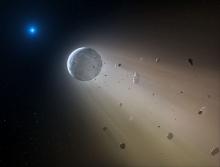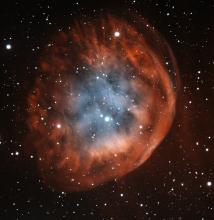Listen to today's episode of StarDate on the web the same day it airs in high-quality streaming audio without any extra ads or announcements. Choose a $8 one-month pass, or listen every day for a year for just $30.
You are here
Dynamic Butterfly
The Butterfly Nebula is aptly named. Like a butterfly here on Earth, it’s spreading its wings as it emerges from its “cocoon.” And it’s happening in a hurry -- fast enough for astronomers to see changes over periods of just a few years.
The “butterfly” is also known as NGC 6302. It represents the death throes of a star a few times the mass of the Sun. The star is casting off its outer layers of gas. Its exposed core is one of the hottest stars ever seen. Ultraviolet light from the core zaps the surrounding gas, causing it to glow.
The gas has been sculpted into a shape like an hourglass. From our angle, the lobes of the hourglass look like the wings of a butterfly. The nebula could be shaped by a companion star -- or maybe two companions -- orbiting along the “waist” of the hourglass. The dying star might even have swallowed a companion.
Astronomers recently compared pictures of the nebula snapped 11 years apart by Hubble Space Telescope. The images showed that high-speed “jets” of gas from the dying star are blowing material in the outer regions of the wings at almost two million miles per hour. The jets cross and tangle, creating complex and turbulent structures -- changing the wings of the butterfly.
NGC 6302 is close to the upper right of the “stinger” of the scorpion, which is low in the south as night falls. The nebula is too faint to see with the unaided eye, but it’s an easy target for binoculars or a telescope.
Script by Damond Benningfield





